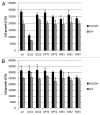Analysis of glutamine dependency in non-small cell lung cancer: GLS1 splice variant GAC is essential for cancer cell growth
- PMID: 22892846
- PMCID: PMC3469476
- DOI: 10.4161/cbt.21348
Analysis of glutamine dependency in non-small cell lung cancer: GLS1 splice variant GAC is essential for cancer cell growth
Abstract
One of the hallmarks of cancer is metabolic deregulation. Many tumors display increased glucose uptake and breakdown through the process of aerobic glycolysis, also known as the Warburg effect. Less studied in cancer development and progression is the importance of the glutamine (Gln) pathway, which provides cells with a variety of essential products to sustain cell proliferation, such as ATP and macromolecules for biosynthesis. To this end Gln dependency was assessed in a panel of non-small cell lung cancer lines (NSCLC). Gln was found to be essential for the growth of cells with high rates of glutaminolysis, and after exploring multiple genes in the Gln pathway, GLS1 was found to be the key enzyme associated with this dependence. This dependence was confirmed by observing the rescue of decreased growth by exogenous addition of downstream metabolites of glutaminolysis. Expression of the GLS1 splice variant KGA was found to be decreased in tumors compared with normal lung tissue. Transient knock down of GLS1 splice variants indicated that loss of GAC had the most detrimental effect on cancer cell growth. In conclusion, NSCLC cell lines depend on Gln for glutaminolysis to a varying degree, in which the GLS1 splice variant GAC plays an essential role and is a potential target for cancer metabolism-directed therapy.
Figures






References
MeSH terms
Substances
LinkOut - more resources
Full Text Sources
Other Literature Sources
Miscellaneous
